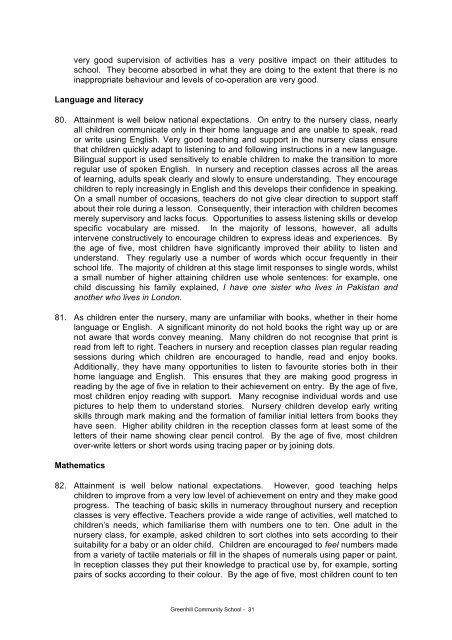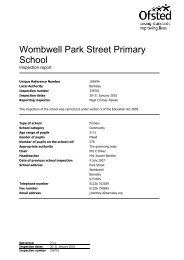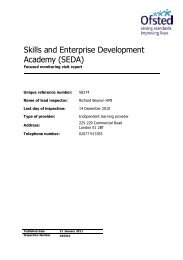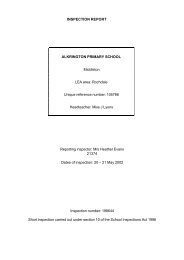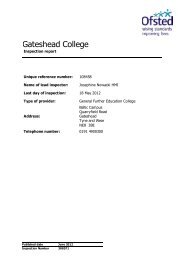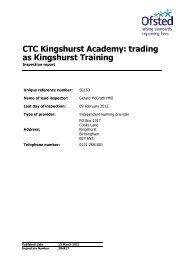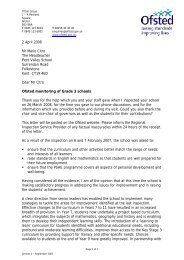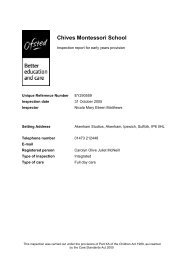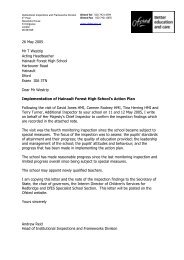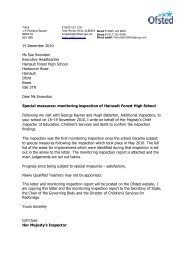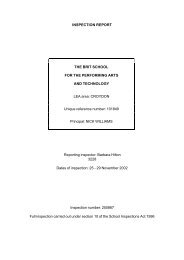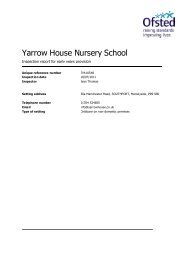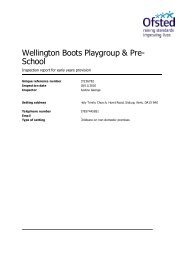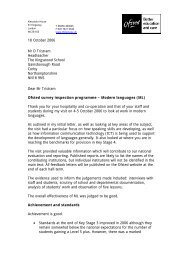pdf School inspection report - Ofsted
pdf School inspection report - Ofsted
pdf School inspection report - Ofsted
You also want an ePaper? Increase the reach of your titles
YUMPU automatically turns print PDFs into web optimized ePapers that Google loves.
very good supervision of activities has a very positive impact on their attitudes to<br />
school. They become absorbed in what they are doing to the extent that there is no<br />
inappropriate behaviour and levels of co-operation are very good.<br />
Language and literacy<br />
80. Attainment is well below national expectations. On entry to the nursery class, nearly<br />
all children communicate only in their home language and are unable to speak, read<br />
or write using English. Very good teaching and support in the nursery class ensure<br />
that children quickly adapt to listening to and following instructions in a new language.<br />
Bilingual support is used sensitively to enable children to make the transition to more<br />
regular use of spoken English. In nursery and reception classes across all the areas<br />
of learning, adults speak clearly and slowly to ensure understanding. They encourage<br />
children to reply increasingly in English and this develops their confidence in speaking.<br />
On a small number of occasions, teachers do not give clear direction to support staff<br />
about their role during a lesson. Consequently, their interaction with children becomes<br />
merely supervisory and lacks focus. Opportunities to assess listening skills or develop<br />
specific vocabulary are missed. In the majority of lessons, however, all adults<br />
intervene constructively to encourage children to express ideas and experiences. By<br />
the age of five, most children have significantly improved their ability to listen and<br />
understand. They regularly use a number of words which occur frequently in their<br />
school life. The majority of children at this stage limit responses to single words, whilst<br />
a small number of higher attaining children use whole sentences: for example, one<br />
child discussing his family explained, I have one sister who lives in Pakistan and<br />
another who lives in London.<br />
81. As children enter the nursery, many are unfamiliar with books, whether in their home<br />
language or English. A significant minority do not hold books the right way up or are<br />
not aware that words convey meaning. Many children do not recognise that print is<br />
read from left to right. Teachers in nursery and reception classes plan regular reading<br />
sessions during which children are encouraged to handle, read and enjoy books.<br />
Additionally, they have many opportunities to listen to favourite stories both in their<br />
home language and English. This ensures that they are making good progress in<br />
reading by the age of five in relation to their achievement on entry. By the age of five,<br />
most children enjoy reading with support. Many recognise individual words and use<br />
pictures to help them to understand stories. Nursery children develop early writing<br />
skills through mark making and the formation of familiar initial letters from books they<br />
have seen. Higher ability children in the reception classes form at least some of the<br />
letters of their name showing clear pencil control. By the age of five, most children<br />
over-write letters or short words using tracing paper or by joining dots.<br />
Mathematics<br />
82. Attainment is well below national expectations. However, good teaching helps<br />
children to improve from a very low level of achievement on entry and they make good<br />
progress. The teaching of basic skills in numeracy throughout nursery and reception<br />
classes is very effective. Teachers provide a wide range of activities, well matched to<br />
children’s needs, which familiarise them with numbers one to ten. One adult in the<br />
nursery class, for example, asked children to sort clothes into sets according to their<br />
suitability for a baby or an older child. Children are encouraged to feel numbers made<br />
from a variety of tactile materials or fill in the shapes of numerals using paper or paint.<br />
In reception classes they put their knowledge to practical use by, for example, sorting<br />
pairs of socks according to their colour. By the age of five, most children count to ten<br />
Greenhill Community <strong>School</strong> - 31


